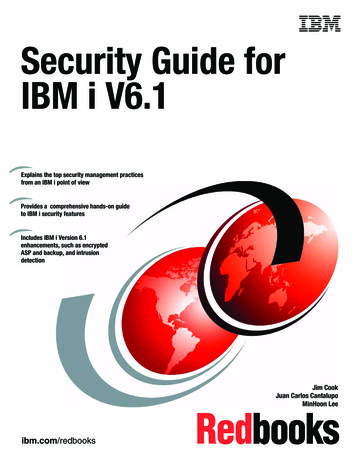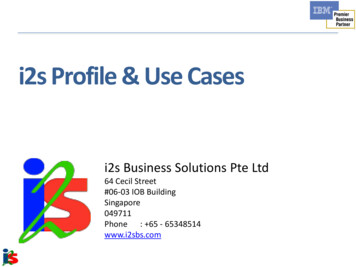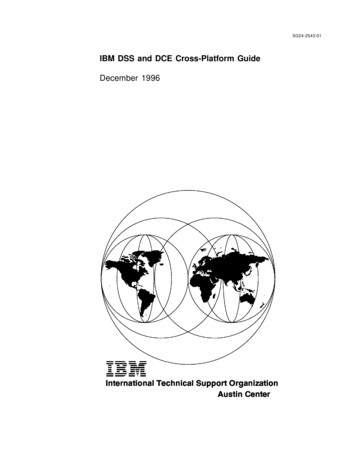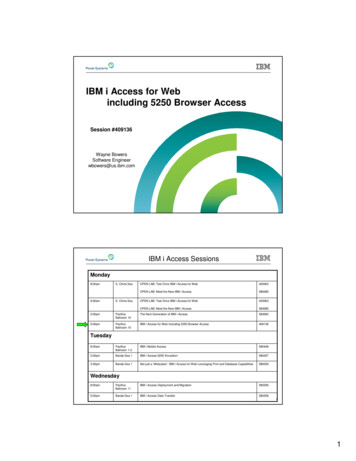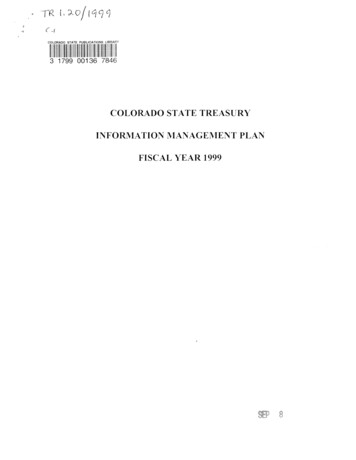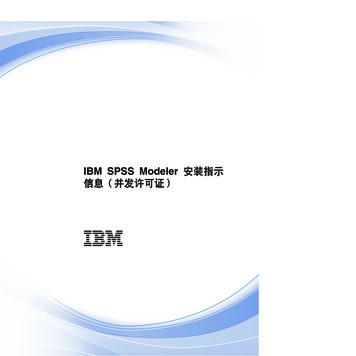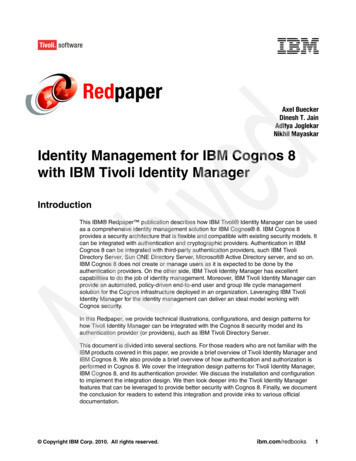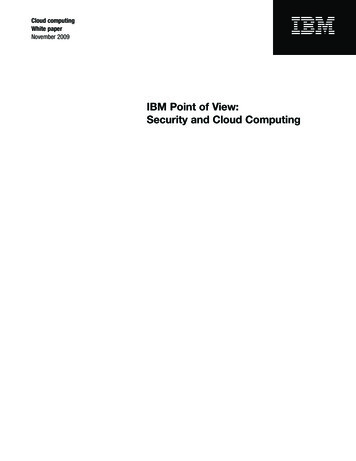
Transcription
Cloud computingWhite paperNovember 2009IBM Point of View:Security and Cloud Computing
Cloud computingPage 2Table of ContentsIntroduction .Address cloud security—the grand challenge .Evaluate different models of cloud computing .Examine the IBM Security Framework .Security governance, risk management and compliance .People and identity .Data and information .Application and process .Network, server and endpoint .Physical infrastructure .Understand the IBM Point of View on cloud security .No “one size fits all” for security .A basic architectural model for cloud computing .Cloud security and SOA .An opportunity to simplify security controls and defenses .34688991011121212151719
Cloud computingPage 3IntroductionCloud computing is a flexible, cost-effective and proven delivery platform for providing business orconsumer IT services over the Internet. Cloud resources can be rapidly deployed and easily scaled, with allprocesses, applications and services provisioned “on demand,” regardless of user location or device.As a result, cloud computing gives organizations the opportunity to increase their service deliveryefficiencies, streamline IT management and better align IT services with dynamic business requirements.In many ways, cloud computing offers the “best of both worlds,” providing solid support for core businessfunctions along with the capacity to develop new and innovative services.As an added benefit, cloud computing enhances the user experience without adding to its complexity.Users do not need to know anything about the underlying technology or implementations.Both public and private cloud models are now in use. Available to anyone with Internet access, publicmodels include Software as a Service (SaaS) clouds like IBM LotusLive , Platform as a Service (PaaS)clouds such as IBM Computing on Demand , and Security and Data Protection as a Service (SDPaaS)clouds like the IBM Vulnerability Management Service.Private clouds are owned and used by a single organization. They offer many of the same benefits aspublic clouds, and they give the owner organization greater flexibility and control. Furthermore, privateclouds can provide lower latency than public clouds during peak traffic periods. Many organizationsembrace both public and private cloud computing by integrating the two models into hybrid clouds. Thesehybrids are designed to meet specific business and technology requirements, helping to optimize securityand privacy with a minimum investment in fixed IT costs.
Cloud computingPage 4Although the benefits of cloud computing are clear, so is the need to develop proper security for cloudimplementations. The following pages provide an overview of key security issues related to cloudcomputing, concluding with the IBM Point of View on a secure cloud architecture and environment.Address cloud security—the grand challengeIn addition to the usual challenges of developing secure IT systems, cloud computing presents an addedlevel of risk because essential services are often outsourced to a third party. The “externalized” aspect ofoutsourcing makes it harder to maintain data integrity and privacy, support data and service availability,and demonstrate compliance.In effect, cloud computing shifts much of the control over data and operations from the clientorganization to their cloud providers, much in the same way that organizations entrust part of their IToperations to outsourcing companies. Even basic tasks, such as applying patches and configuring firewalls,can become the responsibility of the cloud service provider, not the end user. As a result, clients mustestablish trust relationships with their providers and understand risk in terms of how these providersimplement, deploy and manage security on their behalf. This “trust but verify” relationship between cloudservice providers and clients is critical because the clients are still ultimately responsible for complianceand protection of their critical data, even if that workload has moved to the cloud. In fact, someorganizations choose private or hybrid models over public clouds because of the risks associated withoutsourcing services.Other aspects about cloud computing also require a major reassessment of security and risk. Inside thecloud, it is difficult to physically locate where data is stored. Security processes that were once visible arenow hidden behind layers of abstraction. This lack of visibility can create a number of security andcompliance issues.
Cloud computingPage 5In addition, the massive sharing of infrastructure with cloud computing creates a significant differencebetween cloud security and security in more traditional IT environments. Users spanning differentcorporations and trust levels often interact with the same set of compute resources. At the same time,workload balancing, changing service-level agreements (SLAs) and other aspects of today’s dynamic ITenvironments create even more opportunities for misconfiguration, data compromise and maliciousconduct.Infrastructure sharing calls for a high degree of standardized and process automation, which can helpimprove security by eliminating the risk of operator error and oversight. However, the risks inherent with amassively shared infrastructure mean that cloud computing models must still place a strong emphasis onisolation, identity and compliance.Cloud Computing IndustryApplicationsSoftware as a ServicePAASWeb 2.0Application lingPlatform as a ServiceData CenterFabricIAASServersNetworkingInfrastructure as a ServiceStorage
Cloud computingPage 6Evaluate different models of cloud computingDifferent models of cloud computing have various ways of exposing their underlying infrastructure to theuser. This influences the degree of direct control over the management of the computing infrastructure andthe distribution of responsibilities for managing its security.With the SaaS model, most of the responsibility for security management lies with the cloud provider.SaaS provides a number of ways to control access to the Web portal, such as the management of useridentities, application level configuration and the ability to restrict access to specific IP address ranges orgeographies.Cloud models like Platform as a Service allow clients to assume more responsibilities for managing theconfiguration and security for the middleware, database software and application run-time environments.The Infrastructure as a Service (IaaS) model transfers even more control—and responsibility for security—from the cloud provider to the client. In this model, access is available to the operating system supportingvirtual images, networking and storage.Organizations are intrigued with these cloud computing models because of their flexibility and costeffectiveness, but they are also concerned about security. Recent cloud adoption studies by industryanalysts and articles in the press have confirmed these concerns, citing the lack of visibility and control,concerns about the protection of sensitive information and storage of regulated information in a shared,externally managed environment.A mass adoption of external, massively shared and completely open cloud computing platforms for criticalIT services is considered to be still a few years away.
Cloud computingPage 7In the near term, most organizations are looking at ways to leverage the services of external cloudproviders. These clouds would be used primarily for workloads with a low-risk profile, where a one-sizefits-all approach to security with few assurances is acceptable, and where price is the main differentiator.For workloads with a medium- to high-risk profile involving highly regulated or proprietary information,organizations are choosing private and hybrid clouds that provide a significant level of control andassurance. These workloads will be shifting into external clouds as they start offering tighter and moreflexible security.IBM Security FrameworkSECURITY GOVERNANCE, RISK MANAGEMENTAND COMPLIANCEPEOPLE AND IDENTITYDATA AND INFORMATIONAPPLICATION AND PROCESSNETWORK, SERVER AND END POINTPHYSICAL INFRASTRUCTURECommon Policy, Event Handling and reand software
Cloud computingPage 8Examine the IBM Security FrameworkThe IBM Security Framework was developed to describe security in terms of the business resources thatneed to be protected, and it looks at the different resource domains from a business point of view.Based on the IBM Security Framework and informed by extensive discussions with IBM clients, thefollowing section provides a list of major security requirements in enterprise-class cloud computing today.(For more information, see IBM Security Framework and IBM Security Blueprint to Realize BusinessDriven Security, IBM RedGuide REDP-4528-00, July 2009.)Security governance, risk management and complianceOrganizations require visibility into the security posture of their cloud. This includes broad-based visibilityinto change, image and incident management, as well as incident reporting for tenants and tenant-specificlog and audit data.Visibility can be especially critical for compliance. The Sarbanes-Oxley Act, the Health InsurancePortability and Accountability Act (HIPAA), European privacy laws and many other regulations requirecomprehensive auditing capabilities. Since public clouds are by definition a “black box” to the subscriber,potential cloud subscribers may not be able to demonstrate compliance. (A private or hybrid cloud, on theother hand, can be configured to meet those requirements).In addition, providers sometimes are required to support third-party audits, and their clients can bedirected to support e-Discovery and forensic investigations when a breach is suspected. This adds evenmore importance to maintaining proper visibility into the cloud.In general, organizations often cite the need for flexible SLAs that can be adapted to their specificsituation, building on their experiences with strategic outsourcing and traditional, managed services.
Cloud computingPage 9People and identityOrganizations need to make sure that authorized users across their enterprise and supply chain have accessto the data and tools that they need, when they need it—all while blocking unauthorized access. Cloudenvironments usually support a large and diverse community of users, so these controls are even morecritical. In addition, clouds introduce a new tier of privileged users: administrators working for the cloudprovider. Privileged-user monitoring, including logging activities, becomes an important requirement. Thismonitoring should include physical monitoring and background checking.Identity federation and rapid on-boarding capabilities must be available to coordinate authenticationand authorization with the enterprise back-end or third-party systems. A standards-based, single sign-oncapability is required to simplify end-user logons for both internally hosted applications and the cloud,allowing end users to easily and quickly leverage cloud services.Data and informationMost organizations cite data protection as their most important security issue. Typical concerns include theway in which data is stored and accessed, compliance and audit requirements, and business issuesinvolving the cost of data breaches, notification requirements and damage to brand value. All sensitive orregulated data needs to be properly segregated on the cloud storage infrastructure, including archived data.Encrypting and managing encryption keys of data in transit to the cloud or at rest in the serviceprovider’s data center are critical to protect data privacy and comply with compliance mandates. Theencryption of mobile media and the ability to securely share those encryption keys between the cloudservice provider and consumer is an important and often overlooked need. Because moving large volumesof data quickly and cheaply over the Internet is still not practical in many situations, many organizationsmust send mobile media, such as an archive tape, to the cloud provider. It is critical that the data isencrypted and that only the cloud provider and client have access to the encryption keys.
Cloud computingPage 10Significant restrictions regarding data collocation can arise with cloud computing, depending on anorganization’s location, the type of data it handles and the nature of its business. Several member states ofthe European Union (EU), for example, expressly forbid the nonpublic personal information of its citizensto leave their borders.A number of U.S. state governments do not allow the nonpublic personal information of its employees tobe sent offshore.Additionally, a cloud deployment can raise export-law violation issues relative to encrypted information,and the deployment can potentially expose intellectual property to serious threats. The organization’s legalcounsel must perform a thorough review of all these requirements prior to cloud deployment, making surethe organization can maintain control over the geographic location of data in the provider infrastructure.In areas involving users and data with different risk classes that are explicitly identified (such as publicand financial services), organizations need to maintain cloudwide data classification. The classification ofthe data will govern who has access, how that data is encrypted and archived, and how technologies areused to prevent data loss.Application and processClients typically consider cloud application security requirements in terms of image security. All of thetypical application security requirements still apply to the applications in the cloud, but they also carryover to the images that host those applications. The cloud provider needs to follow and support a securedevelopment process. In addition, cloud users demand support for image provenance and for licensing andusage control. Suspension and destruction of images must be performed carefully, ensuring that sensitivedata contained in those images is not exposed.
Cloud computingPage 11Defining, verifying and maintaining the security posture of images vis-à-vis client-specific securitypolicies is an important requirement, especially in highly regulated industries. Organizations need toensure that the Web services they publish into the cloud are secure, compliant and meet their businesspolicies. Leveraging secure-development best practices is a key requirement.Network, server and endpointIn the shared cloud environment, clients want to ensure that all tenant domains are properly isolated andthat no possibility exists for data or transactions to leak from one tenant domain into the next. To helpachieve this, clients need the ability to configure trusted virtual domains or policy-based security zones.As data moves further from the client’s control, they expect capabilities like Intrusion Detection andPrevention systems to be built into the environment. The concern is not only intrusions into a client’strusted virtual domain, but also the potential for data leakages and “extrusions”—that is to say, the misuseof a client’s domain to mount attacks on third parties. Moving data to external service providers raisesadditional concerns about internal and Internet-based denial of service (DoS) or distributed denial ofservice (DDoS) attacks.Because information security is a moving target, the environment must be reviewed on a regular basisagainst prevalent threats and common vulnerabilities.In a shared environment, all parties must agree on their responsibilities to review data and perform thesereviews on a regular basis. The organization must take the lead in terms of contract management for anyrisk assessments or controls deployment that it does not perform directly.Where image catalogs are provided by the cloud provider, clients want these images to be secure andproperly protected from corruption and abuse. Many clients expect these images to be cryptographicallycertified and protected.
Cloud computingPage 12Physical infrastructureThe cloud’s infrastructure—including servers, routers, storage devices, power supplies and othercomponents that support operations—should be physically secure. Safeguards include the adequate controland monitoring of physical access using biometric access control measures and closed circuit television(CCTV) monitoring. Providers need to clearly explain how physical access is managed to the servers thathost client workloads and that support client data.Understand the IBM Point of View on cloud securityIBM offers an informed perspective on cloud security based on extensive experience in the design,implementation and support of cloud computing solutions across a range of vertical industries.No “one size fits all” for securityThere is no one-size-fits-all model for security in the cloud. Organizations have different securityrequirements that are determined by the unique characteristics of the business workload they intend tomigrate to the cloud.Organizations have many different requirements for integration between the cloud environment and theirenterprise back-end systems. Some organizations are developing entirely new applications and are preparedto build their cloud environment to be independent from any existing operations, but most enterpriseclients will start with a hybrid or private cloud where integration with their enterprise systems is a centralrequirement.
Cloud computingPage 13In this context, the ease with which the existing security management infrastructure can be extendedinto the cloud—and, in particular, the use of federation protocols—are important contributors to asuccessful deployment. Identity federation protocols such as OpenID and Security Assertion MarkupLanguage (SAML) receive a great deal of public attention and play an important role for public clouds, butin the enterprise a variety of other protocols need to be supported. These protocols all have the objectiveof quickly moving data from the enterprise back-end systems into the private or hybrid cloud.Different types of workloads require different levels of security. One of the top requirements is the needfor a third-party security audit or validation, and governments are even expressing a need for formalvalidation and certification. The strength of identity proofing—making sure that the users who log on to theservice are really who they claim they are—and the strength of authentication mechanisms will varydepending on the workload type. In response, new public services for identity verification are being set up,offering varying degrees of service quality.Encryption requirements are very different from one client to another. Certain clients mandate the useof specific crypto-algorithms and require very high restrictions on who can have access to the keys, whileother clients may demand encryption only for specific data and may want to delegate key management to atrusted cloud service provider.There is a large variation in availability requirements, including the time allowed for the provider toreact to and recover from failure. Requirements also vary for the intervals at which security andcompliance checks are performed.It is IBM’s point of view that a provider of enterprise-class cloud services must support a range ofsecurity and service-level options, as well as an extensible and industry standards-based securityinfrastructure that makes it easy to integrate with existing operations. In addition, the service providermust integrate with and extend the client’s cloud security capabilities as needed.
Cloud computingPage 14The Layers of a Typical Cloud ServiceCloud DeliveredServicesApplication as a serviceApplication software licensed for use as aservice, provided to customers on demandPlatform as a serviceOptimized middleware — application servers,database servers, portal serversCloudPlatformInfrastructure as a serviceVirtualized servers, storage, networkingBusiness Support ServicesOffering Management, Customer Management,Ordering Management, BillingOperational Support ServicesInfrastructure Provisioning, Instance, Image,Resource/Asset ManagementVirtualized ResourcesVirtual Network, Server, StorageSystem ResourcesNetwork, Server, StoragePhysical System and Environment
Cloud computingPage 15A basic architectural model for cloud computingA basic architectural model for cloud computing consists of a stack of layered services. The physical systemlayer describes normal data center requirements, mandating access control measures and monitoring of thefacility. The system resources layer governs network, server and storage infrastructure. The virtualizedresources layer introduces strong isolation as the core property of virtualization security: isolating processesthrough hypervisors and data segregation.The next layers are the operational support services (OSS) and business support services (BSS) thatdefine the cloud management platform. At the top are the various cloud-delivered services ofInfrastructure as a Service, Platform as a Service and Application as a Service.Security requirements exist at each layer of this architecture, and it is critical to maintain consistencyamong these layers. For example, if a security policy at the highest level of the stack defines that customerinformation cannot leave the country, then at the lower level of physical resources, disk space must beallocated in-country that will store that data.
Cloud computingPage 16The Layers of a Typical Cloud ServiceIdentityOperational Support ServicesInfrastructure Provisioning, Instance, Image,Resource/Asset ManagementVirtualized ResourcesVirtual Network, Server, StorageSystem ResourcesNetwork, Server, StoragePhysical System and EnvironmentIdentityBusiness Support ServicesOffering Management, Customer Management,Ordering Management, Billing Control of privileged user access(provider admins, subscriber admins) Efficient subscriber on-boardingCompliance Federated identity, authorization,entitlementsCompliance Audit and compliance reporting,intrusion detection and preventionIsolation Secure separation of subscriberdomains, secure integration withexisting enterprise securityinfrastructure Policy-based approach Multi-tenant log management,compliance reporting Image image and VM integrity,image provenanceIsolationPlatform as a serviceOptimized middleware — application servers,database servers, portal serversInfrastructure as a serviceVirtualized servers, storage, networkingCloudPlatformSOA SecuritySecure Virtualized RuntimeCloud DeliveredServicesApplication as a serviceApplication software licensed for use as aservice, provided to customers on demand Process isolation (in particular,at hypervisor/VM-level) Provisioning with security andlocation constraints Data segregation, data encryption Multi-tenant security services
Cloud computingPage 17Cloud security and SOAThe cloud architecture described here allows us to construct a very simple model of cloud securityconsisting of two main concepts: an SOA security layer that resides on top of a new Secure VirtualizedRuntime layer.The Cloud Delivered Services layer is a complex, distributed SOA environment. Different services canbe spread across different clouds within an enterprise. The services might be in different administrative orsecurity domains that connect together to form a single cloud application. The SOA Security Model fullyapplies to the cloud. The Web Services (WS) protocol stack forms the basis for SOA security and, therefore,also for cloud security. This security model is fully supported across the IBM software stack. (For moreinformation on these products and the SOA security model, refer to IBM Redbook SG24-7310-01,Understanding SOA Security). A solution such as IBM Tivoli Federated Identity Manager provides broad,standards-based support for bridging various security domains to deliver seamless user access to cloudservices. This is especially important when tying together internal IT resources with third-party cloudservices in a hybrid cloud model, or when packaging several third-party services in a branded offering toend customers.One of the key aspects of SOA is the ability to easily integrate different services from different providers.Cloud computing is pushing this model one step further than most enterprise SOA environments, since acloud sometimes supports a very large number of tenants, services and standards. This support is providedin a highly dynamic and agile fashion, and under very complex trust relationships. In particular, a cloudSOA sometimes supports a large and open user population, and it cannot assume a pre-establishedrelationship between cloud provider and subscriber.Many cloud implementations focus on specific protocols, such as OpenID for identity federation, andfavor specific architectural styles, such as representational state transfer (REST). It is IBM’s point of viewthat enterprise-class cloud computing must not limit its users to a specific protocol or style, but rather,offer flexibility and choice. While IBM supports REST-based interfaces and protocols where appropriate,SOA security needs the full range of security services as described in the SOA Security Reference Model.
Cloud computingPage 18A basic concept in SOA is to externalize security into services, and make these available for use by otherservices.Standards-based proofing, enrollment and authentication of users to cloud services represent only the tipof the iceberg for ensuring that the right users have access to the right resources. Consistent policies forentitlements and access control are needed to ensure that all underlying components of a cloud servicemaintain data confidentiality and adhere to compliance regulations. For example, a medical researchapplication pulls data from clinical and billing services from multiple hospitals, so patient names and otherpersonally identifiable information must be removed from all sources. A centralized entitlementsmanagement service, like IBM Tivoli Security Policy Manager, can help ensure that common policy isdefined and enforced to protect patient confidentiality across all cloud services.Cloud providers can support SaaS and IaaS within and across clouds. The provider should adhere toimplementation best practices and provide clients with maximum visibility into the security andcompliance posture of cloud services. The IBM Rational AppScan portfolio can help supportapplication security. IBM Tivoli Security Information and Event Manager provides consolidated views ofsecurity audit logs and prepackaged reports that can be used to demonstrate compliance efforts andidentify threats from privileged insiders. The ability to monitor and respond to threats posed by privilegedIT administrators takes on heightened importance in the public cloud model, where third-partyadministrators have access to the data of many different organizations.The Secure Virtualized Runtime layer on the bottom is a virtualized system that runs the processes thatprovide access to data on the data stores. This run time differs from classic run-time systems in that itoperates on virtual machine images rather than on individual applications. It provides security servicessuch as antivirus, introspection and externalized security services around virtual images.
Cloud computingPage 19While the foundations of Secure Virtualized Runtime predate SOA security and are built on decades ofexperience with mainframe architectures, the development of Secure Virtualized Runtime is still very muchin flux. IBM continuously invests in research and development of stronger isolation at all levels of thenetwork, server, hypervisor, process and storage infrastructure to support massive multitenancy.The provisioning of virtual resources enforces security domains and location constraints. Virtualresources must be grouped based on policy, and the automation of security configuration managementhelps ensure consistency.Within Secure Virtualized Runtime, security services are also increasingly externalized through SOAservices, providing identity, audit, key management, policy and other services. The IBM Proventia Virtualized Network Security Platform is an extensible virtual security platform that provides threatm
Cloud computing Although the benefits of cloud computing are clear, so is the need to develop proper security for cloud implementations. The following pages provide an overview of key security issues related to cloud computing, concluding with the IBM Point of View on a secure cloud architecture and environment.



